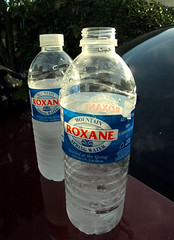Polymer Basics

This quiz is open notes, open web. It is worth a regular Quiz grade. Please complete to the best of your ability.
- 1.
What is a Polymer?
- A.
A long chain molecule made of many smaller molecules called monomers
- B.
A small molecule made of one atom
- C.
A large molecule made of twisted chains
- D.
A large molecule in the shape of the letter "P"
Correct Answer
A. A long chain molecule made of many smaller molecules called monomers -
- 2.
Which one of these is NOT true?
- A.
Polymers are made of monomers
- B.
Zinc is a great atom for making polymers because of its four valence electrons.
- C.
Linear polymers tend to be stretchy.
Correct Answer
B. Zinc is a great atom for making polymers because of its four valence electrons.Explanation
Carbon is great for making polymers because of its four electrons. Zinc does not form polymers.Rate this question:
-
- 3.
The plastic bottles shown in this picture are made of what TYPE of polymer?
- A.
Natural
- B.
Synthetic (man-made)
- C.
DNA
- D.
Latex
Correct Answer
B. Synthetic (man-made)Explanation
PLASTIC is a synthetic or man-made polymer. The other three choices are natural and not used to make bottles.Rate this question:
-
- 4.
This shape of a polymer, because of the branching structure, will most likely have what property?
- A.
Stretchy
- B.
Stores energy
- C.
Strong and able to hold weight
Correct Answer
C. Strong and able to hold weight -
- 5.
The process by which small monomers chemically bond to form a large polymer is known as ________.
Correct Answer
polymerization, PolymerizationExplanation
Polymerization is the chemical process where small molecules, known as monomers, join together to form a long-chain polymer. There are two main types of polymerization: addition polymerization and condensation polymerization. In addition polymerization, monomers add to each other without the loss of any small molecules, while in condensation polymerization, monomers bond together with the release of a small molecule, often water. This process is crucial in the production of various synthetic polymers like plastics and rubber.Rate this question:
- 6.
List 5 characteristics or "properties" of plastics.
- 7.
Which one of the following is NOT a natural polymer?
- A.
DNA
- B.
Carbohydrates
- C.
Polyethylene
- D.
Latex
Correct Answer
C. Polyethylene -
- 8.
Which of the following is NOT a synthetic or man-made polymer?
- A.
Polypropylene
- B.
Nylon
- C.
Teflon
- D.
Carbohydrates
Correct Answer
D. CarbohydratesExplanation
Carbohydrates are natural polymers, not synthetic. They are organic compounds composed of carbon, hydrogen, and oxygen, and they serve as an essential source of energy for living organisms. Carbohydrates like starch and cellulose are natural polymers made from sugar monomers. On the other hand, polypropylene, nylon, and Teflon are synthetic, man-made polymers commonly used in industries for producing plastic goods, fabrics, and non-stick surfaces respectively. These are created through chemical processes, unlike carbohydrates which are naturally occurring.Rate this question:
-
- 9.
Which of the following recycling codes would be found on the bottom of a plastic water bottle?
- A.
5, PP
- B.
4, LDPE
- C.
1, PETE
- D.
3, V
Correct Answer
C. 1, PETE -
- 10.
Which one of the following polymer structures is known to be STRONG?
- A.
Linear
- B.
Branched
- C.
Ring
Correct Answer
B. Branched -
- 11.
The Greek work "plasticos" literally means....
- A.
Moldable, able to be shaped
- B.
Weak
- C.
Easy to break
Correct Answer
A. Moldable, able to be shaped -
- 12.
Plastics are made from this starting material.
- A.
Plants
- B.
Petroleum or oil
- C.
Dirt
Correct Answer
B. Petroleum or oil -
Quiz Review Timeline +
Our quizzes are rigorously reviewed, monitored and continuously updated by our expert board to maintain accuracy, relevance, and timeliness.
-
Current Version
-
Sep 08, 2024Quiz Edited by
ProProfs Editorial Team -
Dec 02, 2009Quiz Created by
Serokat




